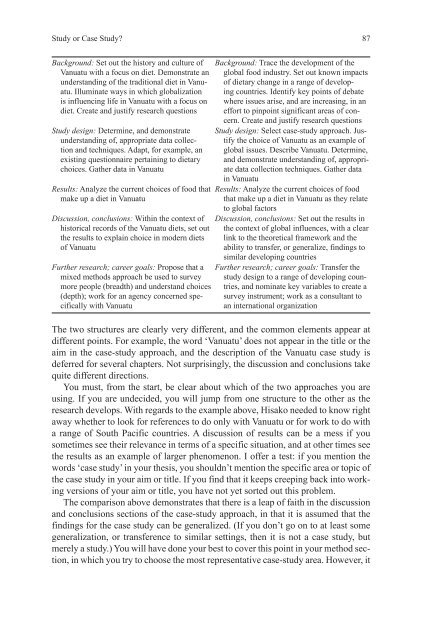How-to-Write-a-Better-Thesis
Create successful ePaper yourself
Turn your PDF publications into a flip-book with our unique Google optimized e-Paper software.
Study or Case Study? <br />
87<br />
Background: Set out the his<strong>to</strong>ry and culture of<br />
Vanuatu with a focus on diet. Demonstrate an<br />
understanding of the traditional diet in Vanuatu.<br />
Illuminate ways in which globalization<br />
is influencing life in Vanuatu with a focus on<br />
diet. Create and justify research questions<br />
Study design: Determine, and demonstrate<br />
understanding of, appropriate data collection<br />
and techniques. Adapt, for example, an<br />
existing questionnaire pertaining <strong>to</strong> dietary<br />
choices. Gather data in Vanuatu<br />
Results: Analyze the current choices of food that<br />
make up a diet in Vanuatu<br />
Discussion, conclusions: Within the context of<br />
his<strong>to</strong>rical records of the Vanuatu diets, set out<br />
the results <strong>to</strong> explain choice in modern diets<br />
of Vanuatu<br />
Further research; career goals: Propose that a<br />
mixed methods approach be used <strong>to</strong> survey<br />
more people (breadth) and understand choices<br />
(depth); work for an agency concerned specifically<br />
with Vanuatu<br />
Background: Trace the development of the<br />
global food industry. Set out known impacts<br />
of dietary change in a range of developing<br />
countries. Identify key points of debate<br />
where issues arise, and are increasing, in an<br />
effort <strong>to</strong> pinpoint significant areas of concern.<br />
Create and justify research questions<br />
Study design: Select case-study approach. Justify<br />
the choice of Vanuatu as an example of<br />
global issues. Describe Vanuatu. Determine,<br />
and demonstrate understanding of, appropriate<br />
data collection techniques. Gather data<br />
in Vanuatu<br />
Results: Analyze the current choices of food<br />
that make up a diet in Vanuatu as they relate<br />
<strong>to</strong> global fac<strong>to</strong>rs<br />
Discussion, conclusions: Set out the results in<br />
the context of global influences, with a clear<br />
link <strong>to</strong> the theoretical framework and the<br />
ability <strong>to</strong> transfer, or generalize, findings <strong>to</strong><br />
similar developing countries<br />
Further research; career goals: Transfer the<br />
study design <strong>to</strong> a range of developing countries,<br />
and nominate key variables <strong>to</strong> create a<br />
survey instrument; work as a consultant <strong>to</strong><br />
an international organization<br />
The two structures are clearly very different, and the common elements appear at<br />
different points. For example, the word ‘Vanuatu’ does not appear in the title or the<br />
aim in the case-study approach, and the description of the Vanuatu case study is<br />
deferred for several chapters. Not surprisingly, the discussion and conclusions take<br />
quite different directions.<br />
You must, from the start, be clear about which of the two approaches you are<br />
using. If you are undecided, you will jump from one structure <strong>to</strong> the other as the<br />
research develops. With regards <strong>to</strong> the example above, Hisako needed <strong>to</strong> know right<br />
away whether <strong>to</strong> look for references <strong>to</strong> do only with Vanuatu or for work <strong>to</strong> do with<br />
a range of South Pacific countries. A discussion of results can be a mess if you<br />
sometimes see their relevance in terms of a specific situation, and at other times see<br />
the results as an example of larger phenomenon. I offer a test: if you mention the<br />
words ‘case study’ in your thesis, you shouldn’t mention the specific area or <strong>to</strong>pic of<br />
the case study in your aim or title. If you find that it keeps creeping back in<strong>to</strong> working<br />
versions of your aim or title, you have not yet sorted out this problem.<br />
The comparison above demonstrates that there is a leap of faith in the discussion<br />
and conclusions sections of the case-study approach, in that it is assumed that the<br />
findings for the case study can be generalized. (If you don’t go on <strong>to</strong> at least some<br />
generalization, or transference <strong>to</strong> similar settings, then it is not a case study, but<br />
merely a study.) You will have done your best <strong>to</strong> cover this point in your method section,<br />
in which you try <strong>to</strong> choose the most representative case-study area. <strong>How</strong>ever, it














![[Lonely Planet] Sri Lanka](https://img.yumpu.com/59845622/1/169x260/lonely-planet-sri-lanka.jpg?quality=85)


